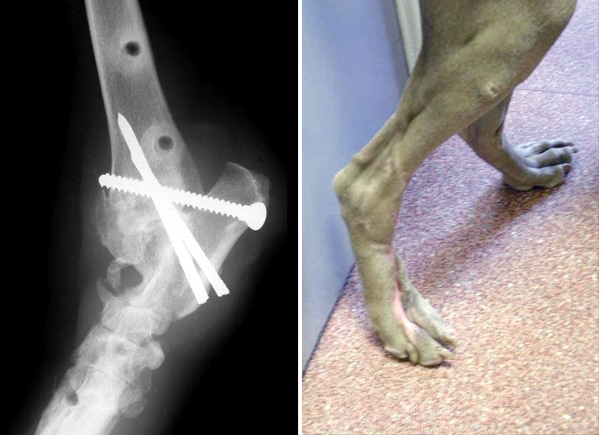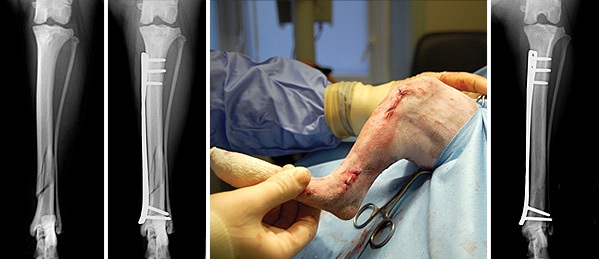
As in people, fractures (broken bones) are relatively common in cats and dogs. Whilst some fractures can be managed using fibreglass casts, surgery is often the best choice of treatment to provide an optimal outcome and allow pets to regain a normal quality of life.
The basic principles of fracture surgery were established many decades ago. These include:
- Accurate re-alignment of the bone fragments
- Rigid fixation to prevent movement at the fracture site
- Avoidance of soft tissue injury to maintain the blood supply to the bone
- Early return to normal use of the affected limb, to minimise joint stiffness and muscle wastage
Unfortunately, it can be difficult to achieve one aim without compromising another. For instance, if an operation is performed to re-align the broken bone, this often results in some degree of damage to the surrounding soft tissues. In the past, complications such as failure of the bone to heal and infection were often seen because of the degree of soft tissue damage. In some cases these complications led to pets needing further surgery or even limb amputation.
Techniques have recently been developed to re-align and stabilise broken bones whilst minimising damage to soft tissues, including blood vessels and the tissues attached to the bone fragments. This is known as minimally invasive fracture surgery.
How is minimally invasive fracture surgery performed?
Firstly the broken bone is re-aligned by manipulation without surgically exposing the fracture fragments. This is often aided by placement of a temporary frame on the bone. Alignment can be checked using an X-ray taken in the operating theatre, if necessary, and at NDSR we have sophisticated X-ray facilities within our operating theatres.
Once the broken bone is re-aligned, it must be rigidly stabilised to allow healing. In some animals this is done by applying a large frame around the limb with pins going through the skin and into the bones. However, looking after these frames necessitates a high level of aftercare. In other patients a plate is slid into a tunnel under the skin and attached to the bone using screws. This provides stability without the need for a large surgical wound or extensive aftercare. This technique is known as minimally invasive plate osteosynthesis, or MIPO.

Repair of a tibial fracture by a minimally invasive technique using a plate and screws that were inserted through two small incisions in the skin. The X-ray on the right shows the same bone several weeks later when it has healed, giving an excellent outcome.
What are the risks and possible complications?
As with any fracture surgery there are some possible complications, but in general the benefits of surgery hugely outweigh the risks. Complications can include infection, poor bone healing and implant breakage. The possible risks for your pet will be discussed with you in detail at your consultation with the orthopaedic surgeon before treatment is started.
How successful is minimally invasive fracture surgery?
Although minimally invasive fracture surgery has been shown to be very successful in human orthopaedics, it is a relatively new technique in small animals. Early results have been very encouraging, showing rapid bone healing with very few complications.
We are always happy to discuss any aspects of a case with you or your vet prior to referral. If you have any questions or concerns please contact us.
Arranging a referral for your pet
If you would like to refer your pet to see one of our Specialists please visit our Arranging a Referral page.